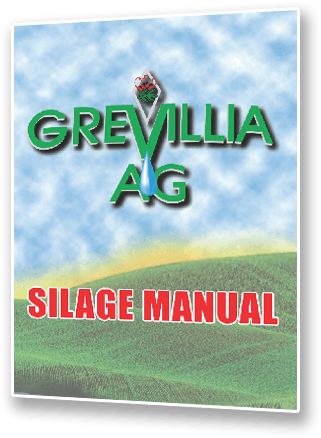Making Silage
Silage Contractors
We can assist you to locate a quality contractor close to you who provide a quality service.
Silage preservation
Good quality silage needs to be well compacted and sealed from air, otherwise the feed quality will degrade as the fermentation process can’t proceed properly, and unwanted bacteria can grow and destroy the silage. E.g. a pit that has mould and yeasts present must have air for these bacteria to grow, so this would indicate that the pit or stack has not been compacted and/or covered properly to exclude air.
To assist in achieving a good fermentation, use of a quality silage inoculant is recommended. There has been significant research around the world to prove that silage inoculants work. Australia is no different, and the research is as applicable to Australia as it is to Europe or the USA.
Why use a silage inoculant?
- Improve fermentation – faster pH drop, and less heating
- Reduce the chances of major spoilage – outcompete the spoilage bacteria
- Prevent nutritional loss
- Keep silage fresh for as long as possible in the pit
- Significantly reduce secondary fermentation, or “heating at feed-out.
- Livestock will eat the lot.
Additionally research has proven that if silage bacteria are applied freshly growing, they can assist in making better silage through faster action compared to freeze dried bacteria that are applied dormant. This research is shown in the following scientific papers.
Kizilsimsek M, Schmidt R J and Kung L Jr.
Effects of a mixture of Lactic Acid bacteria applied as a freeze-dried or fresh culture on the fermentation of Alfalfa silage. J. Dairy Sc. 2007. 90 5698-5705
McAllister TA, Feniuk R, Mir Z, Mir P, Selinger LB an Cheng K.-J
Inoculants for Alfalfa silage: Effects on aerobic stability, digestibility and the growth performance of feedlot steers. Livestock Prod Sc. 53:171-181
Merry RJ, Dhanoa MS & Theodorou MK
Use of freshly cultured lactic acid bacteria as silage inoculants. Grass and Forage Sc. 50:112-123
One of the biggest problems in achieving these results in commercial situations in the past has been the ability to have a commercial silage inoculant with a reasonable shelf life that could be applied to silage in a fresh growing state.
Technical Information on making silage
To help you with making silage, we have developed the following technical information that you can download and print to keep on hand.
One of the biggest problems in achieving these results in commercial situations in the past has been the ability to have a commercial silage inoculant with a reasonable shelf life that could be applied to silage in a fresh growing state
This is no longer the case. Grevillia Ag, through its researcher Dr John Reichelt, has developed a unique technology that enables silage bacteria to be commercially produced, freeze dried and through pre-mixing, be applied to silage in a fresh growing active state. It is Si-Lac Technology, available in the market as Si-Lacand Si-Lac Extra.
Technical Information on making silage
To help you with making silage, we have developed the following technical information that you can download and print to keep on hand.


